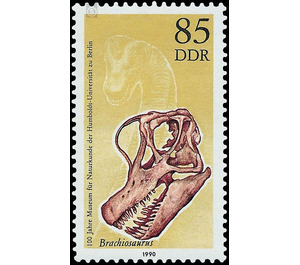100 years Museum for Naturopathy of the Humboldt University Berlin - Germany / German Democratic Republic 1990 - 85 Pfennig
Theme: Animals
| Country | Germany / German Democratic Republic |
| Issue Date | 1990 |
| Face Value | 85.00 |
| Color | yellow |
| Perforation | K 12 1/2: 13 |
| Printing Type | offset |
| Stamp Type | Postage stamp |
| Item Type | Stamp |
| Chronological Issue Number | 3070 |
| Chronological Chapter | GER-DDR |
| SID | 388352 |
| In 15 Wishlists | |
100 Years Museum of Natural History Berlin On the occasion of the 100th anniversary of the Museum of Natural History of the Humboldt University in Berlin, the Ministry of Posts and Telecommunications of the German Democratic Republic issues five multicolored special postage stamps and a miniature sheet. Special Stamps from April 17 to June 16, 1990 100 Years Museum of Natural History Berlin In 1890, the natural history collections of the University of Berlin, combined in the Museum of Natural History, began to make their exhibition rooms accessible to the public in the then newly constructed building. On the special postage stamp series issued for this occasion, some of the dinosaur finds from the Tendaguru strata of East Africa are shown, which also contributed to the attractiveness and the international reputation of the museum. From 1909 to 1912, an expedition of the museum was able to carry out very successful excavations, to whose finds the dinosaur skeletons depicted belong. Dinosaurs have been the dominant animal group on Earth for more than 150 million years. In the Jurassic and Cretaceous periods, their development with giant shapes reached a climax. 85 Pfennig value: Brachiosaurus skull The Originaic skull of the Brachiosaurus exhibited in the Museum of Natural History is an outstanding masterpiece of paleontological preparation art and scientific reconstruction. Only through them is the presentation of these remains of fossil vertebrates in such completeness in a museum exhibition possible. The skull of Brachiosaurus is probably formed largely to relieve weight only by weak bone clips. The brain space was tiny in relation to the size of the body. The outer nostrils were shifted far upwards.


